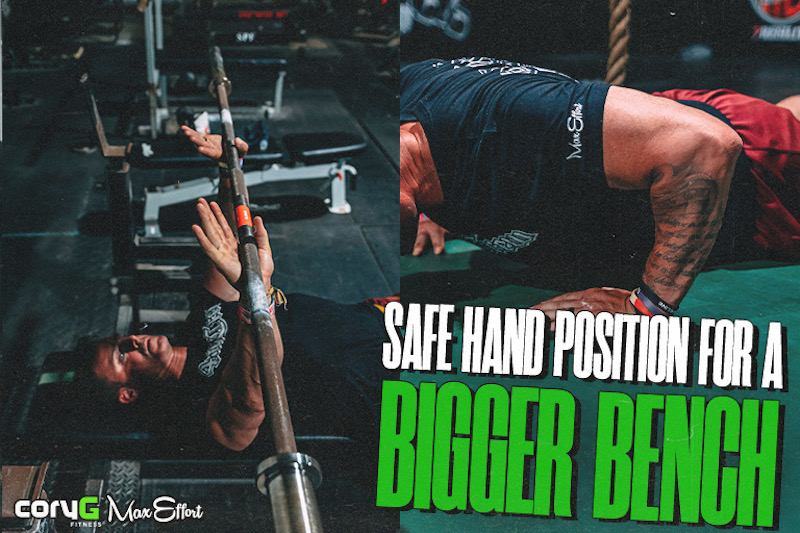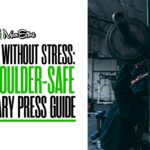
[vc_row][vc_column width=”1/2″][vc_column_text css_animation=”fadeInDownBig”]
Benching 315 Again – Pain-free
In case you missed it, I ruptured my supraspinatus – aka one of my rotator cuffs – a few years ago. I’ve been on a quest to benching 315 pounds again ever since that serious injury occurred. Not only did I want to bench 315 pounds again, but I wanted to be able to do it pain-free.
[/vc_column_text][/vc_column][vc_column width=”1/2″][vc_column_text css_animation=”fadeInDownBig”]
[/vc_column_text][/vc_column][/vc_row][vc_row][vc_column][vc_separator color=”black” style=”shadow” border_width=”2″ css_animation=”fadeIn”][vc_column_text css_animation=”fadeInDownBig”]
Push-up Position
If you’ve paid attention at all to my journey, you know that I’ve been banging out push-ups. They’ve served as another source of GPP work (general physical preparedness). Below is the push-up position that I’m currently utilizing to ensure that I’m not going to aggravate or injure my shoulder.
As you can see in the picture, I’m pointing my hands “in” much more than the regular push-up. Why am I doing this? Number one, it allows you to engage your lats effectively, and two, it allows you to really focus on loading the triceps. Those are the primary movers.
Sure, you’re still going to recruit the rest of the chest and you’re still going to get a nasty pump, but the support of your body weight is really loaded on your rear delts, triceps and lats.
[/vc_column_text][vc_separator color=”black” style=”shadow” border_width=”2″ css_animation=”fadeIn”][/vc_column][/vc_row][vc_row][vc_column width=”1/2″][vc_single_image image=”4354292″ img_size=”large” alignment=”center” style=”vc_box_shadow_3d” css_animation=”fadeInDown”][/vc_column][vc_column width=”1/2″][vc_single_image image=”4354290″ img_size=”large” alignment=”center” style=”vc_box_shadow_3d” css_animation=”fadeInDown”][/vc_column][/vc_row][vc_row][vc_column][vc_separator color=”black” style=”shadow” border_width=”2″ css_animation=”fadeIn”][vc_column_text css_animation=”fadeInDownBig”]
The Bench Press Transfer
The grip carries directly over into my bench press. Today I made 8 sets of 1 rep with 225 pounds, plus 80-100 pounds of band tension. I made 1 set of 1 rep with both 245 and 250, plus the 80-100 pounds of band tension.
All with no shoulder pain.
This positioning was further validated by Westside Barbell legend, Tony Ramos. Through a recent conversation I had with him, he mentioned how you’re drilling this movement pattern over and over, and when executed properly, it’s as if you’re pushing your body away from the floor. It’s the same exact thing with the barbell – you’re pushing the bar away in order to keep it in a straight line.
[/vc_column_text][vc_separator color=”black” style=”shadow” border_width=”2″ css_animation=”fadeIn”][vc_column_text css_animation=”fadeInDownBig”]
Applying What I Learned
If I could go back in my training career, I would have benched this way my entire life. The only difference may be moving my grip out a tiny bit.
On the alternative days I would utilize a wider grip for more pump work. Meaning, my main focus would be to get a sick-nasty pump and to increase my chest volume. Through my rehab and recovery experience, I believe that this is the best way to bench press for the long-term.
Look at some of the greatest bench pressers of all-time, such as Matt Wenning. He’s benched pressed this way his entire career with little to no shoulder issues. This isn’t a coincidence.
I’ve benched 315 pounds since 1998 – every year of my life. I benched 300 pounds at age 17 for the first time. Knowing what I know now, I would still go back and change my grip, knowing what I know now. Why? Because I believe that I may have been a 400-pound bencher.
[/vc_column_text][/vc_column][/vc_row]










